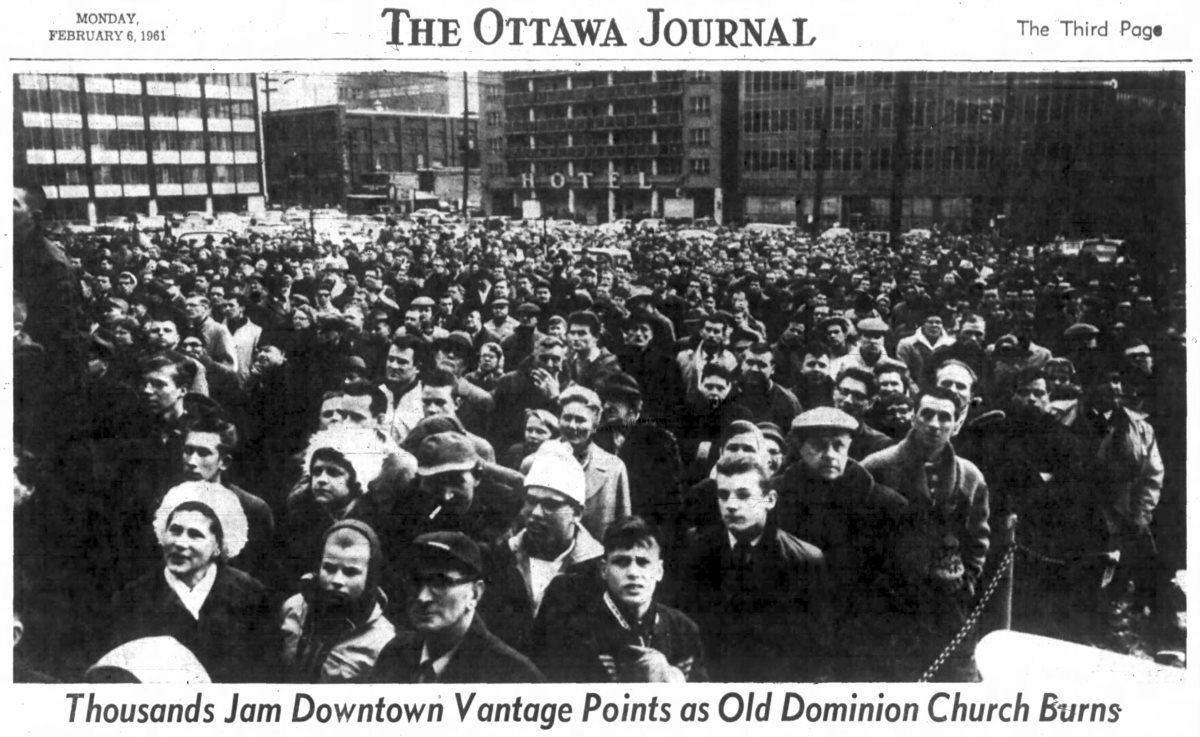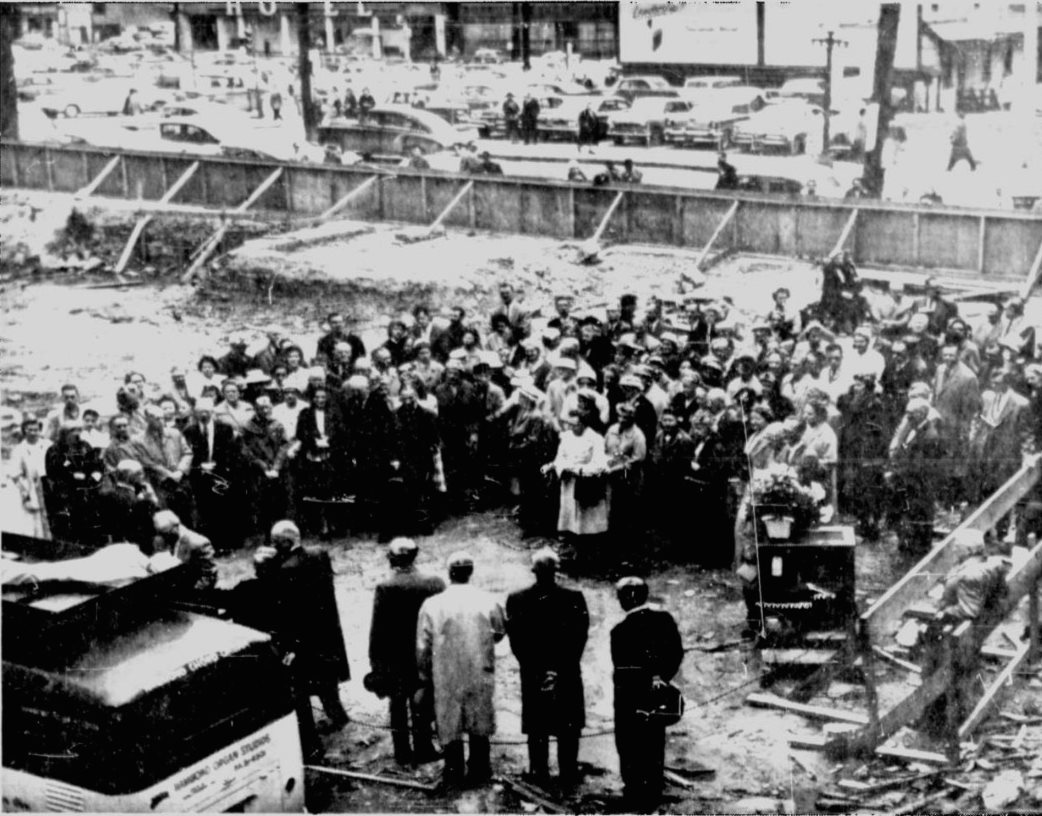Episode 2: What’s in a Name?
Episode 2 is part of Listening Through the Archives, Stories from the CDCC.
By Meredith Boerchers
Have you wondered about the meaning behind Carleton Dominion-Chalmers Centre’s name? While many readers will recognize that the title represents the recent agreement between Carleton University and Dominion-Chalmers United Church, perhaps fewer will realize that “Dominion-Chalmers” points to an even earlier unification between two separate groups. The name “Dominion-Chalmers” was coined in 1962 when two individual churches, Dominion United Church and Chalmers United Church, officially joined as one group based within Chalmers United Church’s building— the monolith built in 1912 and the site of the present-day CDCC.
Previous to their amalgamation, Dominion United Church and Chalmers United Church enjoyed a close relationship. Both groups were members of the United Church of Canada and cared for the community needs of downtown Ottawa. It was common for the churches to combine services through the summer months in the 1950s, and when a fire in 1955 destroyed Chalmers’ Sunday School Hall, Dominion hosted joint morning and evening services while reparations took place. All this was done in a spirit of goodwill and unity, as two groups sharing one faith and concern for the well-being of the surrounding community. The impetus for their official joining, however, sprang from calamity.
On February 4, 1961, a fire broke out in Dominion United Church on Queen and Metcalfe streets. Beginning with an electric heater in the packing room of the art gallery occupying the church’s hall, the flame spread up the rear wall and through the whole room. “The whole corner of the room was on fire,” recounted a witness to the Ottawa Journal, “It spread fast because of all the paper in the room.” The blaze created such heat that the metal of the fire extinguisher fused before it could be deployed by the gallery owner
In the early stages of the fire both the firefighters and the church’s reverend, Dr. Ashford, were hopeful that the flame would be contained to the church hall. A thick firewall separated the sanctuary from the rest of the facility, and the same structural feature had protected Chalmers United Church’s sanctuary from a fire six years earlier. Assuming the blaze was contained, the first firefighters approached the flames through the church’s interior while wearing heavy gas masks. Dr Ashford and a group of 25 bystanders also rushed into the church to rescue valuable items and documents, including the pulpit furniture, collection plates, pulpit robes, and marriage and death records. However, the flames soon jumped the firewall and spread through the space between the ceiling and the roof. Twenty minutes after the Deputy ordered all the people out of the church’s interior, the roof of the balcony where the firefighters had been working collapsed. The blaze then spread quickly, feeding on the heavily varnished woodwork of the interior and using the tall walls of the structure as a chimney.
The fire grew into an inferno that destroyed the entire church. At its peak, 200 firemen fought the blaze at the same time, using six pumpers, three aerial trucks, two ladder trucks, two hose tender carriers and five deluge guns—each capable of firing 500 gallons of water a minute. Smoke could be seen from Camp Fortune in the Gatineau Hills, and soot and ashy flakes fell throughout the surrounding neighborhoods. The extreme volume of water used to fight the blaze created a river six feet wide and two feet deep through Metcalfe and Queen Streets, carrying with it debris from the art gallery and church. Faced with fire and flood, service workers had to create sandbag diversions towards the city sewers. There, the deluge stirred up sediments in the lines and caused city taps to deliver murky fluid for several hours.
Photos and reports in the Ottawa Journal and Ottawa Citizen from this time testify to the fire’s spectacular immensity. Crowds of hundreds of people filled the streets to watch the blaze, with several hundred more crowding into the nearby parking tower and roofs of surrounding buildings. One witness reported that the fire “sounded like crashing glass… tons and tons of burning timber going down all at once.” Another bystander described seeing a swarm of bats fly out of the smoking ceiling when the belfry became too hot. Mayor Charlotte Whitten, who arrived at the scene two hours after the blaze had broken out, proclaimed a civil emergency, allowing the fire department to swiftly expel spectators, tow cars, and cut electrical wires without standard routine procedures.
With their building completely razed, the congregation of Dominion United Church’s next fourteenth months were an anxious time of negotiating with potential developers and other churches in the area. Dominion even found itself in a tax battle with the City of Ottawa: although the Church was planning to rebuild on the same property, the City of Ottawa imposed a commercial tax to the tune of an additional 500 dollars a month just 24 hours after the destructive blaze. This tax levy was eventually rejected by Judge Peter Macdonald, but not before 500 community members gathered on the fire-site to hold open-air worship services in protest.
In January 1962, members of Dominion met with representatives from Chalmers United Church to discuss the possibility of amalgamating the two churches. In the previous October, Chalmers United Church had sent a letter of support to Dominion, saying:
“At a meeting of the official board of Chalmers held last night one of the things uppermost in the minds of those present was the situation in which the people of Dominion find themselves as a result of the disastrous fire last February. Dominion and Chalmers people have been closely associated over the years and have been drawn together by the services held in each summer first in one Church and then the other …. We would be very pleased, if they desired, to appoint a committee of the congregation to discuss the desirability of the two congregations considering a basis for union.”
Due to both the rising cost of rebuilding and the close relationship of the churches, Dominion accepted Chalmers invitation to create a joint committee to establish the possibility of a union. In a matter of months, the amalgamation process was completed and the Inaugural Service for the new Dominion-Chalmers United Church took place on May 8, 1962 in the current site of the CDCC. Thus, two historic congregations in Ottawa joined, reflecting, as the self-published yearbook recounts, “a unity which has been exemplified by the very existence of the United Church of Canada.”
The joining of these two groups manifested not only in the combined church governments and membership records—which expanded to 2 600 names—but also in the physical walls of the Dominion-Chalmers building. Today, the charred cornerstone from Dominion United Church lives on display in the back of the balcony in the CDCC. Four pictorial and two memorial stained-glass windows from Dominion’s ruins are installed in the centre of the north wall of the sanctuary. And perhaps the most colourful and intricate of the stained-glass windows in the collection commemorates the turning point in Dominion-Chalmers’ history: a phoenix, an emblem of renewal and immortality, rising from the flames of a burning church. This scene teaches visitors still today about the tragedy and subsequent renewal that led to a new, exciting chapter in the church’s life. Now that Carleton University has joined in the history of Dominion-Chalmers, we are committed to carrying forward this legacy of community support as a welcoming, professional and safe environment for multigenerational, diverse, and inclusive programming.
The CDCC continues to house many items salvaged from the fire. Dominion’s burned cornerstone is currently on display in the back of the balcony, and six stained glass windows are installed in the north wall. Charred documents have been photographed and gently stored in the archives
Photo Resources
Photos found in CDCC Archives room (see attached folder):
- Dominion before the fire
- 2 pictures of the Church on fire, streets filled with people, water guns
- Crowds on the car park
- Salvaged church sign kept in Dominion-Chalmers’ archives room
- Salvaged cornerstone
- Commemorative stained glass window
Source: Ottawa Journal, February 6, 1961, page 21, via https://www.historynerd.ca/2014/07/31/the-inflammable-dominion/#jp-carousel-1060
Source: Ottawa Journal, February 6, 1961, page 21. Via https://www.historynerd.ca/2014/07/31/the-inflammable-dominion/#jp-carousel-1062
Photo from the Ottawa Journal, February 6, 1961, via https://www.historynerd.ca/2014/07/31/the-inflammable-dominion/
Research Resources
- Bray, Garth. 2012. Dominion-Chalmers United Church. Ottawa: Dominion-Chalmers United Church.
- Dominion-Chalmers United Church. 2002. 40th Amalgamation Anniversary 1962-2002. Ottawa: Dominion-Chalmers United Church.
- News clippings from scrapbooks in the CDCC archives:
- No titles, no authors.
- Ottawa Journal, February 6, 1921, p 21.
- Ottawa Citizen, April 28, 1961, p. 3
- Letters from the CDCC archives
- Midcentury Modernist. 2011. “Dominion United Fire.” Urbsite.
- Chris. 2014. “The Inflammable Dominion.” The Margins of History.
Photo Gallery
Photo Credit: Fangliang Xu and Meredith Boerchers









